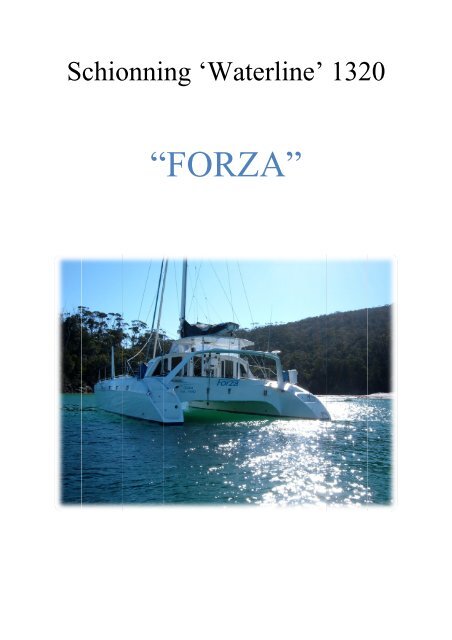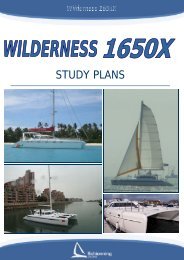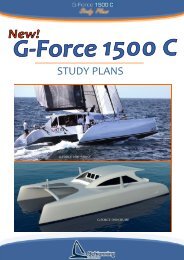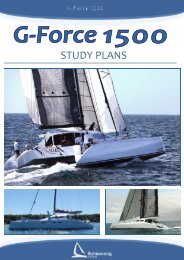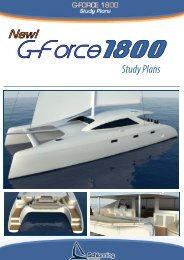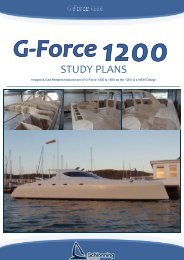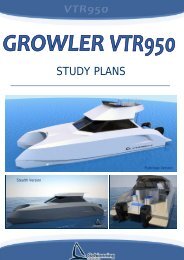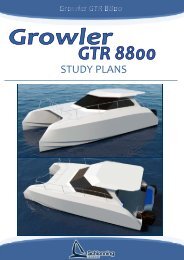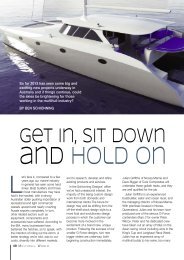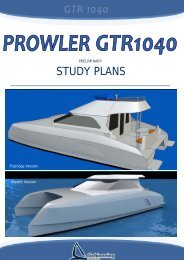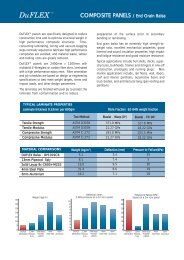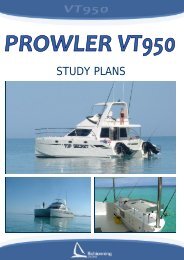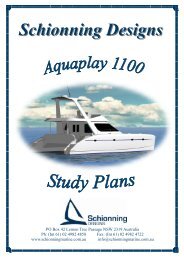Download - Schionning Designs
Download - Schionning Designs
Download - Schionning Designs
- No tags were found...
Create successful ePaper yourself
Turn your PDF publications into a flip-book with our unique Google optimized e-Paper software.
<strong>Schionning</strong> ‘Waterline’1320“FORZA”
Brief Description:‘Waterline 1320’ professionally built to Jeff’s plans with a raised bridge deck.Launched in 2002Length 13.2m Beam 7.35m Draft 1.0m (boards up) 1.8 (boards down)2 x 30hp Yanmar 3YM30 diesel enginesPrice: $475,000History:“Forza” was built in Victoria and the first owner employed professional tradesmen to do theinitial build, finishing and painting, electrics and deck layout etc. She was initially fitted withtwo outboards as per the original plans and sailed to Queensland and back to Melbourne ontwo or three occasions. The main build was done by Ross & Deb McCombe, who are wellknown <strong>Schionning</strong> design builders,and who kindly allowed us to copy lots of their photos ofthe build when we met them in the Kimberley.She was sold in mid to late 2004 to a Queensland buyer who used her around theWhitsundays and also entered some of the popular Queensland races where, we believe, shedid rather well. The second owner had her for about 18 months before deciding to sell herwhich is when we bought her. During this period, the owner had the outboards removed andthe two Yanmar diesels professionally installed.We bought “Forza” in October 2005 with the intention of using her for extended oceancruising as part of our ‘retirement plan’ which is what we did. Initially we sailed her fromQueensland to Hobart where we live and where she is now presently located. We finallysailed north from Hobart 12 months later, in October 2006, after finally retiring and alsofitting additional equipment, as one does!Our initial intention was to cruise the Kimberley during the ’07 dry season and then possiblyreturn to Hobart via the West coast. However, we left Broome about 3-4 weeks too late andended up spending the wet season in Geraldton Marina as the southerlies on that coast arepretty daunting at that time of the year when you are trying to head south. Also, before wereached Geraldton we had decided to go back to Darwin via the Kimberley and enter in the2008 Sail Indonesia Rally.Without going into more detail, we spent the next three and a half years cruising in Indonesia,Malaysia, Thailand, Borneo, Brunei, Philippines, Palau, PNG, Solomon Is, Vanuatu, NewCaledonia and finally back to Coffs in November 2010. Arriving back in Hobart in time to dothe around Tassie Rally in February 2011.
During all our cruising, we had no major problems with ‘Forza’ and she was a wonderfulhome for the two of us and the memories of our trip will always be with us. It is with greatreluctance we have decided to sell her as we do not plan to do any further extended cruisingand it is time to find her a new owner rather than let her sit on a marina for 95% of the time.The following inventory is detailed and extensive but I feel it is the only way to show howwell this beautiful cat is equipped to take you anywhere in the world – just add food!!INVENTORYGeneral Details and layout:As with all Shionning designs, the hull material is balsa core ‘Duflex/Duracore’ composite,bonded with fibreglass and epoxy resin. In addition to the design requirements, Kevlar matwas laid up on the inside of the lower hulls to provide extra strength in case of grounding(whether intentional or unintentional!!)Rudders are free hanging fixed spades with heavy gauge SS tube stocks.The Yanmars are fitted with SD 20 saildrives and propulsion is through “Kiwi” feathering 3blade propellers. These propellers use composite resin based blades which can easily beremoved and serviced/replaced without slipping the boat. There is a spare set of blades andall the necessary tools to do this.The port hull, from forward to aft consists of a deck entry locker for lines, spares and fendersetc; a locker forward of the queen sized cabin which contains hanging space and thewatermaker. Aft of the sleeping cabin is the navigation station and radios etc plus chart table.Aft of this is the head and shower area, there is only one head.The starboard hull also has a similar deck entry locker forward and the locker forward of theother queen cabin has a small 2.2kg automatic washing machine fitted plus hanging space.Aft of the cabin is the galley, which is ‘down’, comprising a 3 burner cooktop, oven, twinbowl sink and combined fridge/freezer. The aft compartment has a double berth with storageunder.The cockpit has a central raised steering position with a comfortable swivel seat for thoselong seagoing watches or being able to see all ‘four corners’ when manoeuvring/berthing.The cockpit seating has lockers below plus the location of the gas bottles and two fuel tanks.All mainsail hoisting and reefing is done at the mast.There is an Aquapro dinghy and two outboard motors.Now for the detail!!
Machinery and electrics:Two 3YM 30 Yanmar diesels fitted with SD 20 saildrives. Both of these engines were fittednew in 2004/2005 and now have around 2450 hrs up. They have been trouble free and the oiland filters have been changed every 150hrs. A detailed log has been kept of all work andmaintenance carried out. The port engine has the standard 60amp alternator which primarilycharges the start battery and the stbd engine has a larger 120amp alternator for the housebatteries. There are workshop manuals for both the engines and saildrives.Fuel is in two 75ltr tanks located in the cockpit seats and with the exception of the commonstart battery, each engine operates independently of the other. In addition to the inbuilt tanksthere are 9 X 20 ltr plastic ‘jerry’ cans stowed in 3 locations forward which brings the totalfuel load up to about 330 ltrs. There is also 20 & 10 ltr ‘jerry’ cans for outboard and generatorpetrol. Diesel fuel consumption is around 2 ltrs per hour per engine at a speed of around 5knots. In addition to the standard Yanmar fuel filter, each engine is fitted with a ‘Racor’ filterand water separator. In addition there is a hand held ‘Baja’ funnel/three stage filter, a mustwhen cruising SE Asia.A Honda Eu 10i portable 1000 watt generator is stowed in a cockpit locker for when therehas been 4-5 days of cloud and the solar panels have not been able to keep up or you havebeen watching too much TV! This was new in 2008 and has about 40-50 hrs up.One 1000 watt ‘Prosine’ pure sine wave inverter, this provides 240 volts AC for the washingmachine, breadmaker, vacuum cleaner and the autostart on the instant gas hot water systemplus whatever other 240volt things you have, provided they do not need over a 1000 watts.There is also an additional 350 watt inverter for the TV and set top box.One ‘Mastervolt’ battery charger powered by the generator or through the shore powercircuits.The shore power system powers the battery charger and 240 volt domestic sockets located inthe galley, navigation station and the central entertainment console.One ‘BEP’ Matrix DC meter which monitors both battery systems, renewed in 2007.Five 60watt solar panels, two on the ‘roll bar’ and three on the cockpit roof these arecontrolled by two BP GCR 2000 regulators. All the panels are set into their locations ratherthan sitting proud.One ??? start battery renewed in 2009 and located under the cockpit seat.Two ???? sealed 130 ah deep cycle house batteries renewed in 2010 and located forward inthe chain locker.
Steering and rudders:As mentioned earlier, the spade rudders are free hanging and are operated hydraulicallythrough a ‘HyDrive’ pump situated below the central helm position. They are relatively easyto remove and replace whilst the boat is in the water.There is an emergency steering tiller located in a saloon locker which I have fitted and triedbut never had to use in a real situation.The steering system is manual and simple, the hydraulic pump is leak free and there are spareseals for the rams.Sails:One mainsail in heavy ‘cruising’ Dacron with 3 reef points and a double leech. It is fullybattened and each reef point is fitted with a turning block to avoid chafe on the reef lines. Itwas renewed by Rolly Tasker in 2009. The reef lines and halyard are all spectra and thehalyard is a double whip. The batten cars are all Harken as are all the various winches andrunning gear. The sail cover is blue and fitted with ‘lazyjacks’.One headsail in heavy cruising Dacron fitted to a ‘Profurl’ roller reefing furler, the sail wasrenewed in 2010, again this is fitted with a spectra halyard. The leech is foam lined and thesolar stop is coloured white.One ‘screecher’ this sail is original and coloured blue with white solar stop. It is not a‘reefable’ sail so “all in or all out” it furls on its own luffline using a ‘Profurl’ furler. This is amagic sail and in 16 knts of breeze we have managed 10-12 knts boat speed with this sailalone. Again, the halyard is spectra.One unused and ‘as new’ storm jib coloured bright rescue pink/red. This has its own spectrahalyard and there are separate lead blocks for the sheets back to the cockpit.Mast:The mast and boom are of carbon fibre construction manufactured by ‘Fibrespar’ and the stepis fixed. The mast is a 7/8 fractional rig, 17.5m long with a single set of spreaders and the
standing rigging is in ‘Dyform’ 12mm wire. It has 2 folding steps below the masthead tomake working on the masthead electrics easier/safer.Deck layout:All gear is ‘Harken’ in stainless steel and original.• Mainsheet on port side of cockpit # 53 - two speed.• Screecher sheets each side of cockpit # 46 – two speed.• Headsail sheets each side of deckhouse # 46 – two speed.• Two halyard winches each side of mast # 40 – two speed.• Reefing winch on boom # 16 – single speed.• Four winch handles.The mainsheet traveller is mounted on the cockpit seatback and is the full width of thecockpit. All cockpit furling and daggerboard lines are led through jammers.There are additional turning blocks for rigging a spinnaker but these have never been used.There are three lifelines on each side with SS stanchions, the upper line is made from 3-4mmSS rod rigging and the lower lines are 8mm spectra. Originally all the lines were SS but Ichanged the lower two to spectra in an attempt at weight saving, the original SS lines willalso go with the sale.There are two safety jackstays running the full length of the boat, one on each side, madefrom 25mm webbing.Two daggerboards operated from the cockpit.Ground tackle:One large ‘Maxwell anchor winch mounted forward of the mast step fitted with a 10mmgypsy to stb’d and a capstan to port. The capstan has a good lead to the mast for hoisting the
osun’s chair. The winch is operated by deck ‘push buttons’ and also an ‘up/down’ switch atthe helm position.One 20 kg ‘Sarka’ anchor with 70m of 10mm chain.One 20 kg ‘Bruce’spare anchor with 10m of 10mm chain and 70m of 25mm plaited nylonrode (this rope doubles as the rode for the drogue).Both anchors were regalvanised in Nov ’10.The anchor bridle is fixed to ‘U’ bolts fitted 150mm above the waterline inboard in each hull.These ‘U’ bolts were renewed in Aug 2011.The bridle has both a ‘light weather’ hook and a‘heavy weather’ hook.Located in the port deck locker is a salt water pressure hose fitted with a pistol nozzle foranchor chain cleaning.Emergency sea tackle:One ‘Bass Strait’ Para-Anchor with a 40m bridle and 100m rope in 25mm plaited nylon plusall the ‘bits and pieces’ to go with it. We always rigged this, as per instructions, during longsea passages but it has never been deployed.One ‘Para-Anchor’ drogue with 10m bridle and 80m rope, again, we have never deployedthis.Sun shades and covers:In the tropics you can never have enough of them!There are 3 sun shades around the cockpit,one each side and one aft between the cockpit ‘roof’ and the ‘roll bar’, these are in a blue UVproof sun shade fabric, these were made in 2007 and restitched by the same sailmaker in2010.
There is one white vinyl sunshade which shades the deck over the saloon and sleeping cabins,we had this made in Palau in 2010. Also a much larger one that does the same job only moreso but a bit harder to rig!There are also fitted covers for each winch and over the liferaft and BBQ.Trampolines:These were renewed in Yamba in 2010 from a UV resistant trampoline mesh and workbrilliantly.Hatches:All hatches are ‘Gebo’ with four deck hatches in each hull, one hatch over each forward bunkand two large hatches over the main saloon seats forward. None of the hatches leak and allcan be locked from the inside. There are also ten ‘Gebo’ insect screens for all hatches in theaccommodation.Cockpit area:The cockpit seating is ‘U’ shaped with four storage lockers under plus the gas bottle lockerand the two fuel tanks. There are removable fitted cushions for this seating in heavy duty blue‘solar stop’ fabric.
The central raised helm position has a comfortable padded waterproof seat which allows thehelmsperson an unobstructed forward view for watch-keeping and manoeuvring. Allelectronic controls/instruments and engine controls are close to hand. There are fitted ‘clears’between the ‘roof’ and the cabin top and the central section is removable for ventilation andgiving the fore deck crew ‘instructions’! These clears will be renewed this year. There is alsoa small ‘Gebo’ opening hatch directly over the helm seat to allow sight of the mainsail andmasthead.There is a bi-fold saloon access door on each side of the raised steering position.The raised steering position also houses, through a hatch, the hydraulic steering pump andautopilot pump and provides some storage. There are also two small circular watertightcompartments, with drains and lids, for drinks and ice.There is a SS ‘Galley Mate’ BBQ mounted on the stb’d quarter of the cockpit and is directlyplumbed into the gas system. The BBQ is easily demounted and works well.Gas system and appliances:Two 4kg gas bottles are stowed in a locker in the port side of the cockpit. They provide gas tothe galley cooktop, oven, BBQ and the ‘Rinnai’ instant hot water system located in the portengine compartment.There is a ‘DVK’ gas sensor alarm system with two detector heads, one detector is in the portengine compartment for the water heater and the other below the galley cooktop.There is also an electronic gas safety control device located in the gas locker.The gas system was inspected and an approval certificate re-issued at the lastslipping/insurance survey in Aug 2011.
Galley equipment/appliances:One SS ‘Smev’ 3 burner gas cooktop with glass lid, mounted outboard and renewed in 2008.One ‘Smev’ gasoven mounted inboard over the working surface.One ‘Iceer’ 12 volt fridge with front opening door into the galley area, combined with a topopening freezer accessed from the saloon above. This Australian made fridge/freezer workswell and is well insulated and never let us down during our time in the tropics.A double bowl sink with hot/cold mixer tap over the forward bowl.A more than adequate supply of cupboards and storage lockers. Cutlery and crockery etc willalso come with the boat.There is also a ‘Sunbeam’ bread-maker which is great if you are in a country where the staplediet is rice!Washing Machine:As mentioned earlier, there is a small 2.2 kg ‘Lemair’ XQBM20-C automatic washingmachine located in the forward hanging space in the stb’d hull. This works well and keeps“her” happy provided there is plenty of water!! (we have been known to spend a night on amarina just to get all the washing done!) This was new in 2007 and is plumbed so water canbe recycled.
Sleeping cabins:The two main sleeping cabins are forward of the saloon and over the underwing in each hull,the sleeping position is athwartships with your head inboard. There is an opening hatch at the‘head’ end and two reading lights. The mattress is high density foam and queen size.The aft stb’d cabin is similar but a double and again the sleeping position is athwartships.All cabins have lockers and the two main cabins have hanging space.The saloon could be utilised to sleep a further 3 adults or four kids.Pillows, doonas and bed linen is available for all beds.
Saloon:This is the usual ‘U’ shaped seating area facing aft where there is a central unit containing aflat screen 23” Panasonic LCD TV and HD set top box. There is also a car stereo with built inCD/DVD player. The TV is connected to a ‘Glomex’ multi-directional ‘flying saucer’antenna on the roll bar. The saloon will seat about eight adults comfortably and all the seatshave lockers under them. The table is triangular in shape and will seat six when using twoottomans. The table is on a single telescopic leg which, when lowered, transforms the unitinto a ‘coffee’ table.There are seven LED and halogen lights in appropriate locations and red LED night lights.The port and stb’d cockpit entry doors have white drop down shades/insect screens to assistwith ventilation but also to keep the mossies out!There is also a Digital ‘weather station’ located on the aft bulkhead above the TV and a‘Pirana’ 240 volt hand held vacuum cleaner stored in one of the under-seat lockers.Head and shower:Located aft in the port hull, the head has a small wash basin with a hot/cold mixer tap and ashower with a hot/cold mixer tap which was renewed in 2010. The shower sump has anautomatically operated discharge pump.The toilet is an electric ‘luxury’ Jabsco and is basically a normal size china loo which facesforward.The boat is fitted with an ‘Electrasan’ sewerage treatment unit which stopped working about3 years ago and I re-routed the toilet discharge directly overboard as SE Asia and Tasmaniahave no requirements with regard to holding tanks or sewerage treatment systems. However,I have now bought the necessary spare parts to repair and re-establish this system if required.It does, however, use a considerable amount of power if operated frequently.
There is a large storage locker in the head with mirror sliding doors. A door behind the toiletgives access to the engine, Electrasan unit, the HF radio ATU and the gas hot water heater.In the warmer ‘climes’ there is also a cold shower located on the aft stb’d steps above the‘swim’ ladder.‘Navigation’ area:This area has bookshelves outboard and two desk areas inboard for paper charts and a laptopcomputer etc. there is also the radio and navigation equipment that will be addressed later.There is also a sliding door shelf unit above for more storage. Under the sloping chart table,which is hinged, there is space for a printer and remote hard drive etc.For security there are two hidden ‘holes’ for passports and cash etc.
Water-maker:Do not go cruising without a water-maker!The water-maker is located in port sleeping cabin hanging locker and is a ‘Spectra’ “SantaCruz”. This is a 12 volt twin pump machine designed to deliver 60 ltrs per hour and has neverlet us down. This machine was installed new when the boat was built however, it was neverused until we had it commissioned in 2006.Being an American made unit the instruction book is voluminous and hard to understand butonce mastered, takes all the worry out of having an adequate supply of fresh water.We replaced the high pressure ‘Clark’ pump in 2010 due to an small, but unstoppable, leak.The service from Spectra was excellent however, the airfreight cost more than the pump!There are numerous spare filters and parts etc. At the moment the unit is shut down and“pickled”.Fresh water is stored in four 150ltr tanks. Two are SS situated inboard in the sleeping cabinhanging lockers and two are integral with the hull under the forward deck/storage lockers.Having the water-maker, we only used the SS tanks (total 300 ltrs) in an effort to keep ourweight down. All four tanks when full are approximately 10% of the weight of the boat!Forward deck lockers:These are entered through a deck hatch in each hull. We use them to store two 20 ltr jerrycans of diesel each plus spare parts, fishing gear, mooring lines, fenders, paint, tools etc etc.There is shelving on each side of each locker so there is quite a lot of usable space.The inspection/cleaning hatches for the integral water tanks are in these lockers.Forward of these lockers are two sealed void spaces and the collision bulkheads.
Communication equipment:• ‘Barrett’ 980E HF radio with full GMDSS DSC distress facility. This was installednew in 2006. The ATU is in the port engine compartment and as close to the port aftstay as I could get. The stay is fitted with the appropriate insulators. This radio issupplemented with a ‘Pactor 3’ modem to allow emails to be sent over the ‘Sailmail’system wherever you are, we also download ‘GRIB’ weather charts over the emailsystem. The modem also allows the downloading of weather faxs,it connects viaBluetooth to a laptop.• ‘Icom’ 1C-M422 VHF radio with DSC distress facility and continuous GPS updatesfrom the plotter. It has a remote ‘command’ mike which is located at the helmposition. This was purchased new in 2009.• Standard ‘Horizon’ HX270S waterproof hand held VHFalso purchased new in 2009,great for comms between dinghy/shore and ‘home’.• Instruction books to go with the above.• ‘Forza’ is a registered ship station with ACMA and has the callsign VJT 6320 and theMMSI Number is 503115900.Navigation instruments & electronics:• Plastimo ‘Offshore 90’ steering compass located at helm position.• Suunto 75mm hand held bearing compass located at helm position.• Raytheon L760 C-series GPS plotter/fish finder/sounder located in navigation area.• Raytheon RL70C Radar display located at the helm position, this unit is also linked tothe plotter system below.• Raytheon ST 5000 autopilot.• Raytheon ST 60 wind direction/speed instrument.• Raytheon ST 60 boat speed instrument.• Raytheon ST 60 depth instrument.• Six ‘C-Map’ NT+ cartridges for the plotter covering Tasmania, Victoria and the eastcoast of Australia also PNG, Indonesia and the South Pacific.• MER model SP24 hand held GPS with waterproof wallet which is part of theemergency ‘grab bag’ equipment.• There are instruction books for all the electronics.• Many and various paper charts covering Australia and some overseas destinations.• Various cruising guides covering Australia and the Pacific, both in book form andelectronic form. (I also wrote lot of cruising information on the areas we sailed in)• Various parallel rules & dividers etc for chartwork.• Pair of 7x50 ‘Bak 4’ binoculars.
Various ‘bits & pieces’:• Portable ‘plug in’ spotlight, sockets located each side of helm position.• Pressure pack type hooter.• Various linen and mats.• Two telescopic aluminium boat-hooks.• A ‘Burke’ bosun’s chair.• Numerous and various spare parts, lubricants and filters.• Two sets of wet weather gear.• Lots of rope, mooring lines and 9 fenders plus plus.• Three expanding files containing instruction booklets, equipment information andaccumulated receipts etc.• ‘Firdell’ radar reflector on fore part of mast.• Lightening conductor on top of mast which is wired to a copper earth plate in theStb’d hull.Dinghy and outboard:The dinghy is a 3.1m ‘Aquapro’ fitted with beaching wheels and a UV protective cover. In‘sea-going’ mode it is hung from the aft ‘roll bar’ and lashed to the transom. It has a smallfolding reef anchor, oars and inflation pump etc.The outboard is a 9.8 hp Tohatsu two-stroke which was bought new in 2006 and runs welleven after almost daily use for 5 years.While the dinghy and outboard are completely operational they are beginning to show theirage.
Safety Equipment:PFD’s• 5 x Adult type 1, 3 x child (various sizes), 1 x ‘Thermofloat’ type 1 adult jacket allstowed in starboard underseat locker in saloon.• 2 x Adult ‘Omega’ type 1 inflatable stowed in forward port hull locker. (serviced2/11)• 2 x Adult type 1 stowed in starboard aft hull locker next to emergency access hatch.Lifebuoys• Two Burke ‘Horseshoe’ lifebuoys in quick deployment bags, both fitted with selfactivating MOB lights and one with small drogue (both lights checked and batteriesreplaced 2/11), located one each side on aft lifelines.• One Burke ‘Retriever Float’ manoverboard retrieval system, located on aft stbdlifelines.Flares• 2 x parachute (exp 9/14) in emergency grab bag.• 2 x red hand held (exp 9/14) in emergency grab bag• 2 x orange smoke hand held (exp 9/14) in emergency grab bag• 2 x orange smoke floats (exp 1/09) in fwd port saloon underseat locker• 1 x “ “ “ (expired) “ “ “ “• 6 x parachute flares “ “ “ “ “• 8 x red hand held flares “ “ “ “ “• 4 x orange smoke hand held (expired) “ “ “ “Fire fighting• 2 x 1 kg dry powder extinguisher stowed under nav station desk, port hull. (pressurechecked & ok 8/12)• 1 x fire blanket “ “ “• 1 x 0.6 kg dry powder extinguisher stowed port side aft in saloon (press ok 8/12)• 1 x 0.6 kg “ “ “ “ stbd hull next to cook top (press ok 8/12)• 1 x fire blanket stowed behind door aft cabin stbd hull• 1 x “ “ “ “ “ fwd locker stbd hull• Salt water 12 volt deck wash hose stowed in external locker on port side of anchorwinch. (hose reaches all parts of boat)• Domestic smoke alarm (battery powered) located on fwd shelf in saloon.
Emergency bilge pumps• 1 x portable hand operated Whale ‘Gusher 30’ fitted on base board with suction anddischarge hoses to reach into either hull and discharge overboard.• 1 x portably 12 volt ‘TMC 200’ electric bilge pump with connection leads anddischarge hose to reach all parts of boat.• 2 x fixed automatic bilge pumps located under each engine.Emergency ‘Grab Bag’Stowed next to nav station in port hull, it contains:• 2 x emergency ‘VEE’ sheets.• 2 x parachute flares (exp 9/14)• 2 x red handheld flares (exp 9/14)• 2 x orange smoke handheld flares (exp 9/14)• 1 x signaling mirror• 1 x Waterproof torch• MER hand held GPS• Hand held VHF with spare batteries.EPIRBGME Class 2 406 EPIRB stowed under nav station in port hull adjacent to the emergencyescape hatch. (batt exp 3/2014) MMSI No: 503115900First AidNumerous first aid equipment including SOLAS and Red Cross kits. Stowed in the headlocker.LiferaftPlastimo/RFD 6 man ‘Offshore’ raft stowed in hard case on fwd mid’ship beam aft offorestay (serviced 2/11) This has a weatherproof cover and will be serviced again at time ofsale.Safety HarnessTwo sets ‘Burke’safety harness in good condition and stowed in open locker in saloon.
Conclusion:When we bought ‘Forza’ we did not know the meaning of the Italian word “forza” and almostconsidered changing the name, however, after consulting Google we discovered the name hasvarious meanings including ‘strength’ ‘force’ and ‘spirit’. After five years of cruising, thesemeanings are very appropriate for our beautiful catamaran and we would hate to see the namechanged.You will have gathered from the above information that ‘Forza’ is equipped and capable ofgoing anywhere and, in our opinion, is hugely suited to a couple who have set their mind onextended cruising. For a couple, she is roomy, easily handled and has good passage-makingin the right wind conditions.While I have tried to include all in the inventory, I am sure there are things I have forgotten.‘Forza’ is registered in Hobart and has the State registration number of ‘4ZA’, she is also anAustralian Registered Ship. She is located on the Prince of Wales Bay Marina in Hobart andis available to view at any time.We feel the asking price of $475.000 is appropriate and it is considerably less than ouroriginal expenditure so we are pretty firm on this price. She is presently insured for $550k.Our contact details are email at charles.weston@iinet.net.au or mobile 0432 679260.Thank you for reading about our catamaran ‘Forza’Sherrye and Charles


